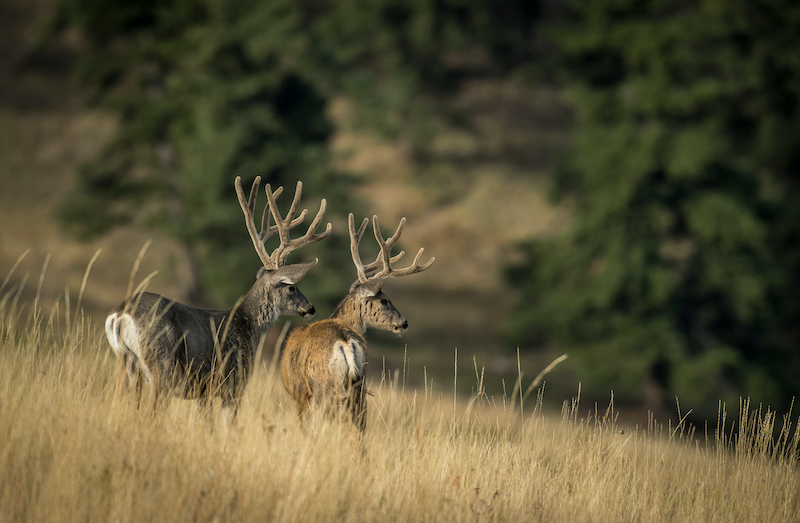White-tailed deer are North America’s most commonly bowhunted big-game species. Bowhunters, however, shouldn’t overlook the whitetail’s big, beautiful Western cousins, the mule deer. Muleys don’t inhabit the widely varied ranges that hold whitetails, but their preference for high country takes bowhunters to many epic places.
“They live up where goats and sheep live; in alpine basins, steep rock chutes and openings,” said Brian Barney, host of Eastman’s Elevated podcast. “To go mountaineering in these peaks above 10,000, 12,000, 13,000 feet; and to be able to survive up there, and then try to get within a stone’s throw of a mule deer, that’s the ultimate challenge.”
The muley’s Western habitats range from deserts to sketchy mountain peaks. During annual migrations, mule deer move from high-country summer range to lower terrain to avoid harsh winters. Bowhunters usually chase muleys in August and September before they leave those steep summer habitats, which has advantages and disadvantages.
One of the biggest challenges of bowhunting muleys is getting to where they live. When bucks live full time at high elevation, it’s often best to make an extended backpacking bowhunt. Scaling peaks with camp on your back requires training and special gear.
“You have to be in good physical shape to survive in that high altitude, and it takes a ton of effort,” Barney said. “It’s way more physically demanding than your average treestand whitetail hunt, but it’s an adventure.”

Mule deer bucks hang out in groups during the summer, so they might be easier to spot. Photo credit: John Hafner
Once you get where muleys call home, things might get easier. “These bucks have a lax summer attitude,” Barney said. “They’re hanging out in bachelor groups with other bucks, and they come out and feed throughout the day.”
Muleys sport their beautiful summer coat into September. This reddish hair is much easier to spot than their winter-gray coat. And because muleys will move around to feed all day, they often provide spot-and-stalk opportunities.
“Finding mule deer is pretty easy,” said Cody Rich, host of The Rich Outdoors podcast, “If you have never done spot-and-stalk, it’s getting into bow range that will take some practice.”
Spot-and-stalk bowhunts are the most common tactic for taking muleys. Most bowhunters find a high vantage point to glass. Once they spot deer, they plot their move. That could mean sneaking in while the deer is bedded, or scoping ways to get in front of it as it moves along.
“It’s like a chess game,” Barney said. A favorite and successful tactic is to stalk bedded deer. He said muleys often bed twice during daylight. He tries to sneak in when they bed the second time later in the morning.
“As you close in on a mule deer, it’s real methodical and slow,” Barney said. “Once you get close, it might take 10 minutes to move 10 steps. You’re looking at every footfall while also watching the deer.”
Some bowhunters sneak in close, and then try to get the deer to stand by throwing a rock or making a noise. Barney, however, prefers to patiently let the deer stand on its own. “I get within my bow range and then wait for the bucks make the last move,” he said.
“Be patient and wait for the right moment,” Rich said. “Too many people rush the stalk or don’t wait for the high probability location. Waiting for the right moment is as important as making all the right moves.”

Make sure you are staying downwind of the deer. Photo Credit: John Hafner
Silence is vital when stalking bedded bucks, but you must also play the wind. The mountains’ fickle winds are friend and foe. The slightest whiff of human odors sends deer running, so never lose track of the wind’s direction. Most bowhunters who stalk muleys don’t use scent-killing sprays and detergents. They rely entirely on playing the wind.
“Mule deer live and die by their nose,” Barney said. “Wind is super important, and you need to eliminate that variable when stalking.”
Stay downwind of the animal by understanding and anticipating weather patterns, and two types of winds: thermals and directionals. Thermal winds ascend and descend as daytime temperatures change in the mountains. Winds typically flow downhill during early-morning hours and again near dusk when temperatures are cool. As the sun rises and air temperatures warm the valley floors, the hotter air rises uphill through draws and canyons from about midmorning through midafternoon.
“Uphill thermals change about 9 a.m. and rise throughout a hot sunny day,” Barney said. “Thermals are a good wind you can count on. As the sun disappears and temperatures cool, the air starts dropping again.”
Hunters use those patterns to plan their hunts. If you’re in a valley and spot a muley on a ridge above, it probably won’t detect you early in the day. But if the thermals begin rising and you don’t adjust, that muley’s nose will likely bust you.
Directional winds are less predictable, so study weather forecasts and monitor your wind indicator. Directional winds in mountains are often strongest in the afternoon, regularly ripping across ridgetops and open faces. Make sure those winds carry your scent away from the deer. When played right, strong winds mask scent and movements, making it easier to sneak in close.
“Make a plan, but experience is the best teacher when hunting mule deer,” Barney said. “They’re the ultimate challenge, so it’s the ultimate reward when you pull it off.”